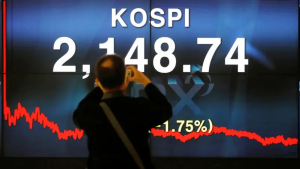Australia's Woodside Energy (WDS.AX) and Santos (STO.AX) said on Thursday they were in preliminary talks to create an A$80 billion ($52 billion) global oil and gas giant, as consolidation among international energy firms intensifies.
Combining two of Australia's largest oil and gas producers would be the largest corporate deal in the country for several years, during which buyout activity has been subdued by rising interest rates and financial market volatility.
Both companies face rising pressures of decarbonisation as well as challenges in their current projects.
Perth-based Woodside, the larger of the two, said the talks with Santos were confidential and incomplete and that there was no certainty a deal would materialise.
"Woodside continuously assesses a range of opportunities to create and deliver value for shareholders," it said in a statement to the Australian stock exchange.
Its market capitalisation stands at A$56.91 billion, while Santos is valued at A$22.1 billion.
A merger of the two would come under close scrutiny from Australia's competition regulator, which has been toughening its stance towards allowing takeovers in concentrated sectors.
"The ACCC is aware of public reports of the potential transaction," a spokesperson for the Australian Competition and Consumer Commission said. "If the potential transaction progresses, the ACCC would consider if a public merger review into the impact on competition is required."
"It (a merger) makes sense given how the share prices have languished and all the capex to come," said Jun Bei Liu, Tribeca Alpha Fund portfolio manager who owns Santos and Woodside shares.
"In today's world oil is almost done so you need to get scale and generate as much profit as possible to invest for the energy transition."
The potential merger follows a string of recent deals in the global oil and gas sector.
Exxon, the largest U.S. oil producer, said on Oct. 11 it had agreed to buy Pioneer Natural Resources (PXD.N) in an all-stock deal valued at $59.5 billion that would make it the biggest producer in the largest U.S. oilfield and secure a decade of low-cost production.
Chevron (CVX.N) struck a deal to buy Hess (HES.N) for $53 billion in stock to gain a bigger U.S. oil footprint and a stake in rival Exxon Mobil's (XOM.N) massive Guyana discoveries, the latest in a series of blockbuster U.S. oil combinations.
There have been existing pressures to simplify the Australian oil and gas sector, which has seen two recent big-cap mergers with Woodside combining with BHP Group's (BHP.AX) oil and gas business and Santos acquiring Oil Search.
"Woodside has already been looking outward after the BHP acquisition and both companies have had good runs with the high oil and gas price environment of the past two years," said Kaushal Ramesh, vice president of LNG Research at Rystad Energy.
Deal discussions with Santos come less than 18 months after Woodside completed the BHP deal and as it grapples to get final approvals for its A$16.5 billion Scarborough venture in Western Australia, its biggest growth project.
L1 Capital, a local hedge fund and STO shareholder, called in September for the company to consider separating out the company’s LNG assets to help boost its share price, which had lagged global and local peers for three years.
Both Woodside and Santos had in annual investor briefings flagged challenging near-term production along with soaring capital expenditure and regulatory hurdles to ongoing projects.
Santos wants to restart work on the Barossa gas project once it finishes a fresh round of talks with conventional landowners.
Firms trying to create value through better funding options and cost reductions amid depressed share prices could also be a potential factor behind the energy majors' possible merger.
Woodside's share price has dropped 15.4% this year so far, while Santos' stock is down 4.3%.











